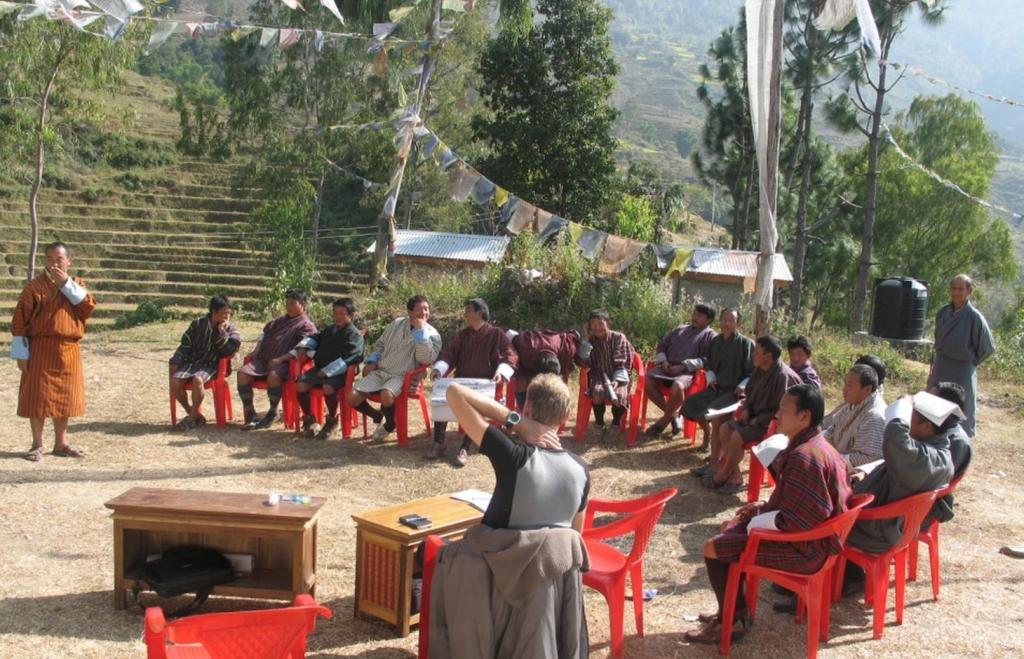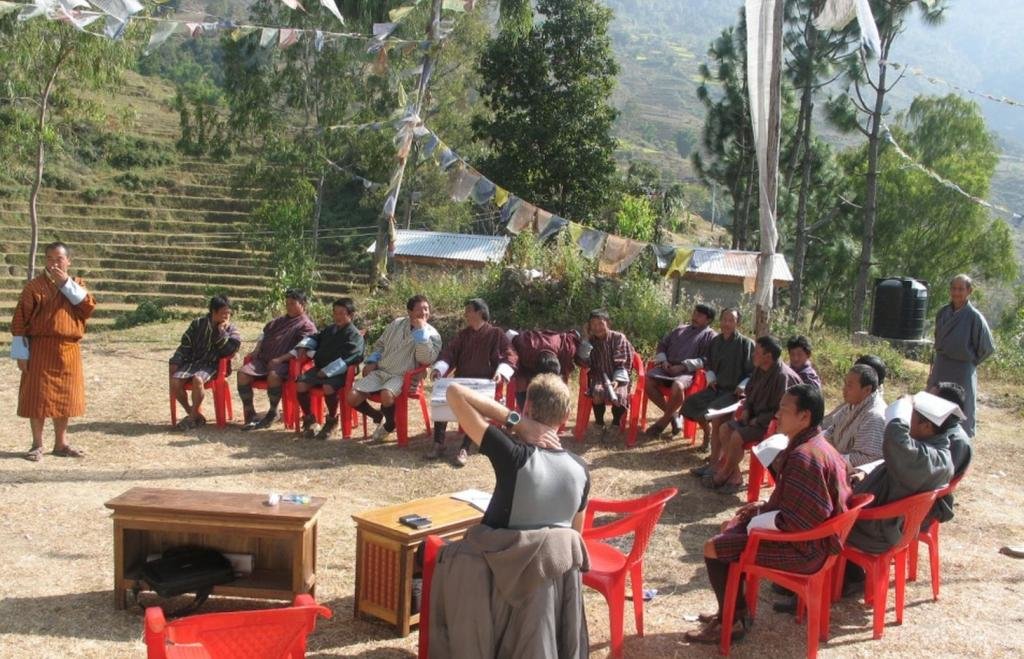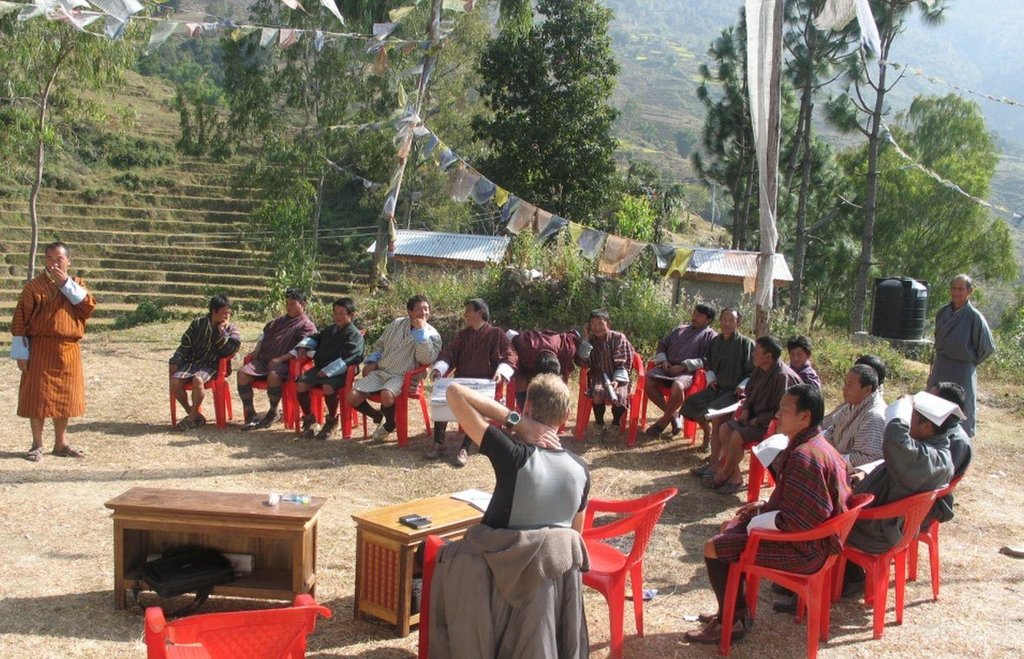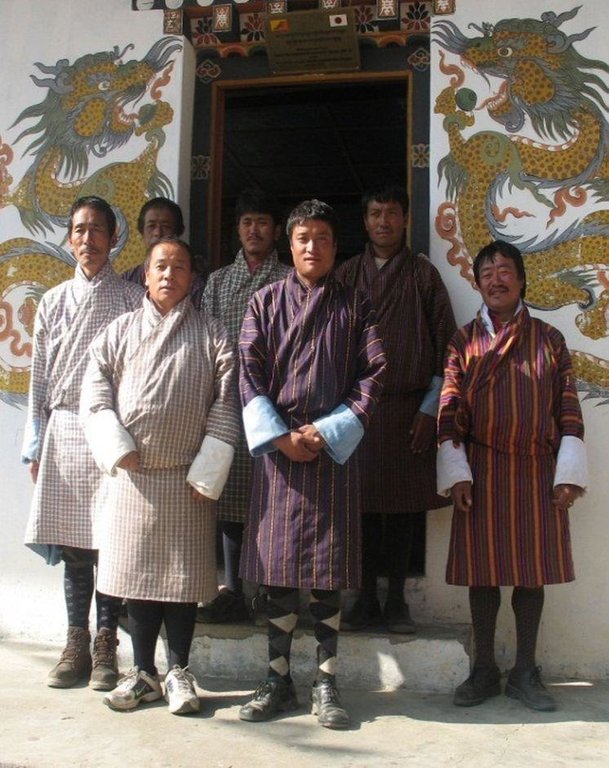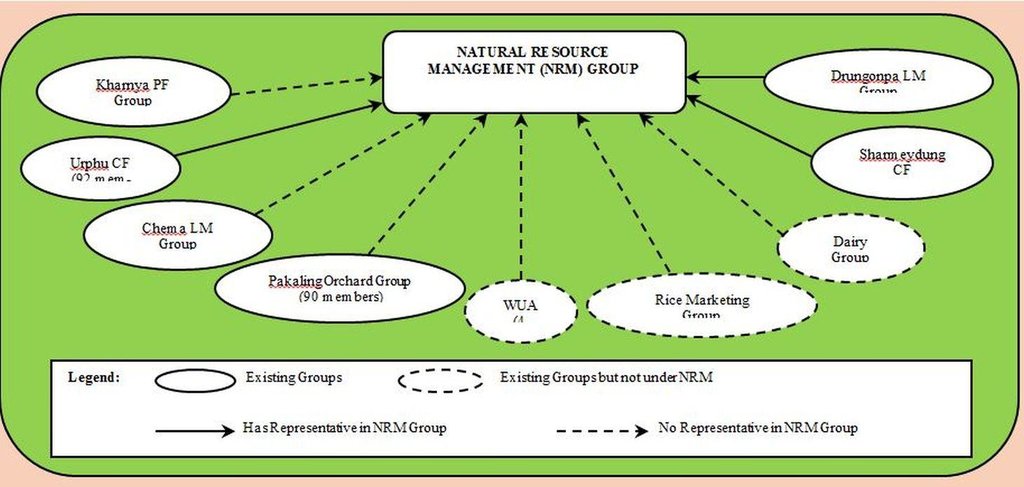Natural Resource Mangement Group [ບູຕານ]
- ການສ້າງ:
- ປັບປູງ:
- ຜູ້ສັງລວມຂໍ້ມູນ: Karma Dorji
- ບັນນາທິການ: –
- ຜູ້ທົບທວນຄືນ: Fabian Ottiger
Rangzhing Nitang Sunchop Tshogpa (Dzongkha)
approaches_2492 - ບູຕານ
ເບິ່ງພາກສ່ວນ
ຂະຫຍາຍທັງໝົດ ຍຸບທັງໝົດ1. ຂໍ້ມູນທົ່ວໄປ
1.2 ລາຍລະອຽດ ການຕິດຕໍ່ ຂອງບຸກຄົນທີ່ຊັບພະຍາກອນ ແລະ ສະຖາບັນ ການມີສ່ວນຮ່ວມ ໃນການປະເມີນຜົນ ແລະ ເອກະສານ ຂອງວິທີທາງ
ຊື່ຂອງ ສະຖາບັນການຈັດຕັ້ງ ທີ່ອໍານວຍຄວາມສະດວກ ໃນການສ້າງເອກກະສານ ຫຼື ປະເມີນແນວທາງ (ຖ້າກ່ຽວຂ້ອງ)
MoA (MoA) - ບູຕານຊື່ຂອງ ສະຖາບັນການຈັດຕັ້ງ ທີ່ອໍານວຍຄວາມສະດວກ ໃນການສ້າງເອກກະສານ ຫຼື ປະເມີນແນວທາງ (ຖ້າກ່ຽວຂ້ອງ)
National Soil Services Centre (National Soil Services Centre) - ບູຕານ1.3 ເງື່ອນໄຂ ຂອງການນໍາໃຊ້ເອກກະສານຂໍ້ມູນ ຂອງ WOCAT
ເມື່ອໃດທີ່ໄດ້ສັງລວມຂໍ້ມູນ (ຢູ່ພາກສະໜາມ)?
23/03/2011
ຜູ້ສັງລວມ ແລະ ບັນດາຜູ້ຕອບແບບສອບຖາມ ຍອມຮັບໃນເງື່ອນໄຂ ການນໍາໃຊ້ຂໍ້ມູນເອກະສານ ທີ່ສ້າງຂື້ນ ໂດຍຜ່ານ ອົງການ WOCAT:
ແມ່ນ
2. ພັນລະນາ ແນວທາງການຄຸ້ມຄອງນໍາໃຊ້ດິນແບບຍືນຍົງ
2.1 ການອະທິບາຍ ໂດຍຫຍໍ້ ຂອງວິທີທາງ
Natural Resource Management Group consisting of village representatives to advocate, plan and implement SLM activities at geog level
2.2 ການອະທິບາຍ ລາຍລະອຽດ ຂອງວິທີທາງ
ການອະທິບາຍ ລາຍລະອຽດ ຂອງວິທີທາງ:
Aims / objectives: The Natural Resource Management (NRM) Group was formally established in Radhi geog in 2000 with representatives from all 20 chiogs of the geog. The main tasks of the group are to :1)mobilise local communities in rehabilitating and protecting natural resources from further degradation and 2) to support geog administration, RNR staff and other agencies in planning, implementing and monitoring sustainable natural resource management activities. Radhi geog in Trashigang Dzongkhag, East-Bhutan, has been confronted with severe land degradation as a result of unsustainable land management practices, such as deforestation, overgrazing and poor irrigation water management. The land degradation processes are related to high population pressure and a series of conflicts between chiogs and with neighbouring geogs about use and access to natural resources. Various stakeholders, engaged with reduction and mitigation of land degradation in Radhi, felt the need for a local institution, which should play a pivotal role in advocacy of sustainable management of natural resources. The group was also intended to assist in implementing remedial and preventive measures at village level.
Methods: The NRM group fulfilled a key role in the afforestation program for the Radhi wa-tershed, in particular the very active Chongdiri ravine, which has caused wide-spread loss of arable land and forced resettlement of households, because of a very active landslide area. The chiog representatives, united in the NRM group, mobilized villagers to actively participate in the afforestation and fencing of the buffer zone. This zone was created to arrest the critical land degradation and change unsustainable land management practices, such as free grazing cattle and irrigated paddy cultivation in an active mass movement area.
Seed money was provided to establish a group fund to provide small-scale loans to households for agricultural inputs in order to overcome existing credit access constraints. The intention was to enhance the viability and sustainability of the NRM Group.
Stages of implementation: Over the last 5 years approximately 250 loans have been disbursed of about US$60 each. The NRM group has a loose umbrella function at geog level over a number of sub-groups at chiog level, related to private forestry, community forestry, bamboo and rice marketing, water user associations and land man-agement. The present group structure needs to be reviewed to adapt to the large number of emerging sub-groups.
2.3 ຮູບພາບຂອງແນວທາງ
2.5 ປະເທດ / ເຂດ / ສະຖານທີ່ບ່ອນທີ່ແນວທາງໄດ້ຖືກນໍາໃຊ້
ປະເທດ:
ບູຕານ
ຂໍ້ມູນເພີ່ມເຕີມຂອງສະຖານທີ່:
Trashigang Dzongkhag, Radhi geog
2.6 ວັນທີເລີ່ມຕົ້ນ ແລະ ສິ້ນສຸດ ການຈັດຕັ້ງປະຕີບັດ ວິທີທາງ
ສະແດງປີຂອງການເລີ່ມຕົ້ນ:
2000
ປີທີ່ສີ້ນສູດ (ຖ້າຢຸດບໍ່ໄດ້ນໍາໃຊ້ ວິທີທາງ):
2012
2.7 ປະເພດຂອງແນວທາງ
- ພາຍໃຕ້ໂຄງການ / ແຜນງານ
2.8 ເປົ້າໝາຍ / ຈຸດປະສົງຫຼັກ ຂອງການຈັດຕັ້ງປະຕິບັດ ວິທີທາງ
The Approach focused mainly on SLM with other activities (cash-income generation, NRM fund for SLM loans/credit facility)
- The main tasks of the group are to: 1) mobilise local communities in rehabilitating and protecting natural resources from further degradation and 2) to support municipality administration, RNR staff and other agencies in planning, implementing and monitoring sustainable natural resource management activities. A series of government programmes and projects initi-ated activities in Radhi geog and it was decided to create a local institution focused at building capacity in NR management, awareness raising and sensitization.
The SLM Approach addressed the following problems: - Widespread severe land degradation in densely populated area, related to forest degradation, overgrazing, poor irrigation water management, unfavourable geological conditions and NR management conflicts between chiogs and between geogs
2.9 ເງື່ອນໄຂອໍານວຍ ຫຼື ຂັດຂວາງການປະຕິບັດຂອງເຕັກໂນໂລຢີ / ເຕັກໂນໂລຢີການນໍາໃຊ້ຕາມແນວທາງ
ສັງຄົມ / ວັດທະນະທໍາ / ມາດຕະຖານ ແລະ ຄຸນຄ່າທາງສາສະໜາ
- ເຊື່ອງຊ້ອນ
Conflicts between geogs (Radhi and Merak) over grazing rights and access, combined with conflicts between chiogs within Radhi over land and water use rights, all contributing to serious land degradation issues in Radhigeog
Treatment through the SLM Approach: Group meetings with chiog representatives; conflict mitigation workshops; formal conflict mitigation and eventually even formal judicial court cases; group formation and support to mitigate land degradation issues and come to consensus
ມີຄວາມສາມາດ / ເຂັ້າເຖິງຊັບພະຍາກອນດ້ານການເງິນ ແລະ ການບໍລິການ
- ເຊື່ອງຊ້ອນ
Limited access to agricultural credit facilities
Treatment through the SLM Approach: Establishment of a local NRM group fund
ກ່ຽວກັບກົດໝາຍ (ສິດນໍາໃຊ້ດິນ, ສິດນໍາໃຊ້ນໍ້າ)
- ອໍານວຍ
The existing land ownership, land use rights / water rights moderately helped the approach implementation: Widespread land tenure facilitates participation level of land users in NRM/SLM activities. Government owned forests have partly been converted to Community Forests, now owned and managed by the local communities. Traditional grazing rights however, have created serious long-lasting inter-geog conflicts that have proved to be difficult to resolve, despite many mediation and judicial efforts.
3. ການມີສ່ວນຮ່ວມ ແລະ ບົດບາດຂອງພາກສ່ວນທີ່ກ່ຽວຂ້ອງທີ່ໄດ້ມີສ່ວນຮ່ວມ
3.1 ຜູ້ມີສ່ວນຮ່ວມ ໃນວິທີທາງ ແລະ ພາລະບົດບາດ ຂອງເຂົາເຈົ້າ
- ຜູ້ນໍາໃຊ້ດິນໃນທ້ອງຖິ່ນ / ຊຸມຊົນທ້ອງຖິ່ນ
NRM group and chiog tshogpas
NRM group is completely male which reflects a local cultural dominance in administrative functions. NRM group provides active support to disadvantaged groups through the NRM group fund, providing access to credit (short-term loans) to enable purchase of seeds/seedlings and other agricultural investments.
- ຜູ້ຊ່ຽວຊານ ການນຄຸ້ມຄອງ ທີ່ດິນແບບຍືນຍົງ / ທີ່ປຶກສາດ້ານກະສິກໍາ
- ພະນັກງານຂັ້ນສູນກາງ (ຜູ້ວາງແຜນ, ຜູ້ສ້າງນະໂຍບາຍ)
RNR-RC Whengkhar
- ອົງການຈັດຕັ້ງ ສາກົນ
3.2 ການມີສ່ວນຮ່ວມຂອງຜູ້ນໍາໃຊ້ທີ່ດິນໃນທ້ອງຖິ່ນ / ຊຸມຊົນທ້ອງຖິ່ນໃນໄລຍະທີ່ແຕກຕ່າງກັນຂອງແນວທາງ
| ການລວບລວມ ເອົາຜູ້ນໍາໃຊ້ດິນ ໃນທ້ອງຖິ່ນ / ຊຸມຊົນທ້ອງຖິ່ນ | ໃຫ້ລະບຸ ຜູ້ໃດທີ່ມີສ່ວນຮ່ວມ ໃນແຕ່ລະກິດຈະກໍາ? | |
|---|---|---|
| ການເລີ່ມຕົ້ນ / ແຮງຈູງໃຈ | ການຮ່ວມມື | Group formation process guided and supported by RNR Research Centres |
| ການວາງແຜນ | ການຮ່ວມມື | Since 2006 through participatory SLM action planning in all 20 Radhi villages with support of NRM group representatives |
| ການປະຕິບັດ | ການຮ່ວມມື | Group members are actively involved with range of NRM/SLM activities, ranging from irrigation channel renovation, orchard development to bamboo plantation, afforestation and buffer zone creation |
| ຕິດຕາມກວດກາ / ການປະເມີນຜົນ | ການຮ່ວມມື | Combined effort of RNR extension staff, geog administration and NRM group members through participatory M&E meetings to get feedback from villagers and provide a platform for technical guidance to the communities |
| Research | ການຮ່ວມມື | Initial phase from 2000 to 2006 RNR Research Centres were actively involved in group formation process and capacity building (e.g. bookkeeping training etc.) |
3.3 ແຜນວາດ (ຖ້າມີ)
ການອະທິບາຍ:
Organisation chart of the NRM group
ຜູ້ຂຽນ:
Hans van Noord (Schoutenkamp 43 Heteren The Netherlands)
3.4 ການຕັດສິນໃຈກ່ຽວກັບການຄັດເລືອກເຕັກໂນໂລຢີຂອງການຄຸ້ມຄອງທີ່ດິນແບບຍືນຍົງ / ເຕັກໂນໂລຢີ
ລະບຸ ຄົນທີ່ຕັດສິນໃຈ ກ່ຽວກັບການຄັດເລືອກຂອງ ເຕັກໂນໂລຢີ / ເຕັກໂນໂລຢີ ຈະໄດ້ຮັບການປະຕິບັດ:
- ຜູ້ນໍາໃຊ້ທີ່ດິນຫຼັກ, ການສະໜັບສະໜູນ ໂດຍຜູ້ຊ່ຽວຊານ ການນໍາໃຊ້ທີ່ດິນແບບຍືນຍົງ
ອະທິບາຍ:
Annual SLM Action Planning in all chiogs, supported by NRM group members at chiog level.
Decisions on the method of implementing the SLM Technology were made by mainly by land users supported by SLM specialists. Consultation process in context of annual SLM action planning and participatory M&E meetings.
4. ການສະໜັບສະໜູນທາງດ້ານວິຊາການ, ການສ້າງຄວາມສາມາດ, ແລະ ການຈັດການຄວາມຮູ້.
4.1 ການສ້າງຄວາມສາມາດ / ການຝຶກອົບຮົມ
ຜູ້ນໍາໃຊ້ທີ່ດິນ ຫຼື ພາກສ່ວນກ່ຽວຂ້ອງອື່ນໆ ໄດ້ຮັບການຝຶກອົບຮົມບໍ່?
ແມ່ນ
ໃຫ້ລະບຸ ຜູ້ໃດທີ່ໄດ້ຮັບການຝຶກອົບຮົມ:
- ຜູ້ນໍາໃຊ້ດິນ
- ພະນັກງານພາກສະໜາມ / ທີ່ປຶກສາ
ຮູບແບບຂອງການຝຶກອົບຮົມ:
- ການເຮັດຕົວຈິງ
- ຕົວຕໍ່ຕົວ
- ກອງປະຊຸມ
- ຫຼັກສູດ
ຮູບແບບຂອງການຝຶກອົບຮົມ:
- study tours
ໃນຫົວຂໍ້:
NRM group members were actively involved in all NRM/SLM training activities at chiog level, but also took part in training courses aimed at improving their capabilities, such as bookkeeping and fund management. NRM group members took part in national and international study tours on SLM and watershed management and shared their experiences on group formation with other NRM groups. Extension staff received targeted training on NRM conflict management.
4.2 ການບໍລິການໃຫ້ຄໍາປຶກສາ
ເຮັດຜູ້ໃຊ້ທີ່ດິນມີການເຂົ້າເຖິງການບໍລິການໃຫ້ຄໍາປຶກສາ?
ແມ່ນ
ລະບຸວ່າການສະໜອງ ການບໍລິການ ໃຫ້ຄໍາປຶກສາ:
- ໃນພື້ນທີ່ຂອງຜູ້ນໍາໃຊ້ດິນ
ອະທິບາຍ / ຄວາມຄິດເຫັນ:
Name of method used for advisory service: Regular guidance and monitoring for the NRM group; Key elements: Fund management and bookkeeping, Key SLM interventions; Regular guidance and monitoring for the NRM group on group dynamics, group fund management, bookkeeping and training programmes on key SLM interventions.
Advisory service is quite adequate to ensure the continuation of land conservation activities; Good level of awareness and knwoledge of NRM/SLM, proven capacity to manage NRM group fund
4.3 ສະຖາບັນການສ້າງຄວາມເຂັ້ມແຂງ (ການພັດທະນາອົງການຈັດຕັ້ງ)
ສະຖາບັນ ໄດ້ຮັບການສ້າງຕັ້ງຂື້ນ ຫຼື ໄດ້ຮັບການສ້າງຄວາມເຂັ້ມແຂງ ໂດຍການຈັດຕັ້ງປະຕິບັດ ວິທີທາງບໍ່?
- ມີ, ຫຼາຍ
ລະບຸ ທາງສະຖາບັນ ໄດ້ສ້າງຄວາມເຂັ້ມແຂງ ໃນລະດັບໃດ (ຫຼາຍ):
- ທ້ອງຖິ່ນ
ລະບຸ ປະເພດ ຂອງສະໜັບສະໜູນ:
- ທາງດ້ານການເງິນ
- ການສ້າງຄວາມອາດສາມາດ / ການຝຶກອົບຮົມ
- ອຸປະກອນ
ໃຫ້ລາຍລະອຽດເພີ່ມເຕີມ:
Seed capital for the NRM fund was provided at the start of the NRM group and later provided by SLMP to enable fund growth and provision of more loans. Interest rate charged by the NRM group fund per loan is 12% per annum (to be repaid in one year, otherwise penalty of 3% applies), equal to market rate.
4.4 ຕິດຕາມກວດກາ ແລະ ປະເມີນຜົນ
ການຈັດຕັ້ງປະຕິບັດ ວິທີທາງ ໄດ້ມີການປະເມີນຜົນ ແລະ ຕິດຕາມບໍ?
ແມ່ນ
ຄວາມຄິດເຫັນ:
bio-physical aspects were regular monitored by project staff, land users through observations; indicators: Regular observations by project staff, group members and land users of stability of degraded areas (size, growth, state)
technical aspects were regular monitored by project staff, land users through observations; indicators: Regular observations by project staff, group members and land users of mortality rate of plantations, area of improved dryland, area of orchard development, state and progress of irrigation channel renovation
socio-cultural aspects were regular monitored by project staff, land users through observations; indicators: Regular observations by project staff, group members and land users of inter-chiog and inter-geog conflicts and progress in conflict mitigation
economic / production aspects were regular monitored by project staff, land users through observations; indicators: Regular measurements by project staff, group members and land users in cash income increase and yield change
economic / production aspects were regular monitored by project staff, land users through measurements; indicators: Regular measurement by project staff, group members and land users of area converted to SLM practice
area treated aspects were regular monitored by project staff, land users through measurements; indicators: Regular observations by project staff, group members and land users of households participating in NRM/SLM activities and making use of NRM group fund loans
no. of land users involved aspects were regular monitored by project staff, land users through observations; indicators: Regular observations by project staff, group members and land users of performance of NRM group, amongst others in municipality council meetings for transparency
management of Approach aspects were monitored by project staff, land users through observations
There were few changes in the Approach as a result of monitoring and evaluation: Changes were made to the NRM group composition and structure and the task and responsibilities with arrival of new government programmes and projects in the geog. By-laws were drafted and updated after involvement of SLMP project in 2006 and NRM group fund expanded, with additional seed money for the group fund.
There were no changes in the Technology as a result of monitoring and evaluation
4.5 ການຄົ້ນຄວ້າ
ນີ້້ແມ່ນສ່ວນໜຶ່ງ ການຄົ້ນຄວ້າ ຂອງວິທີທາງບໍ່?
ແມ່ນ
ລະບຸ ຫົວຂໍ້:
- ສັງຄົມ
ໃຫ້ຂໍ້ມູນ ເພີ່ມເຕີມ ແລະ ກໍານົດ ຜູ້ໃດເຮັດການຄົ້ນຄວ້າ:
Research was actively involved in the initial stages of the NRM group establishment, with special attention to the conflicts between Radhi and Merakgeogs on grazing land (double grazing as result of winter grazing for semi-nomadic yak herders and summer grazing for cattle from lower altitudes, resulting in severe land degradation).
Research was carried out on-farm
5. ການສະໜັບສະໜູນທາງດ້ານການເງິນ ແລະ ອຸປະກອນຈາກພາຍນອກ
5.1 ງົບປະມານປະຈໍາປີ ສໍາລັບວິທີທາງ ຂອງການຄຸ້ມຄອງ ທີ່ດິນແບບຍືນຍົງ
ຖ້າຫາກບໍ່ຮູ້ຈັດງົບປະມານທີ່ແນ່ນອນ ແມ່ນໃຫ້ປະມານເອົາ:
- 2,000-10,000
ຄໍາເຫັນ (ຕົວຢ່າງ: ແຫຼ່ງຂໍ້ມູນຫຼັກ ຂອງການສະໜອງທຶນ / ຜູ້ໃຫ້ທຶນທີ່ສໍາຄັນ):
Approach costs were met by the following donors: international (Seed funding, SLMP contributions): 80.0%; local government (district, county, municipality, village etc) (local community and geog administration (including RNR extension staff)): 15.0%; local community / land user(s) (membership contributions): 5.0%
5.2 ການສະໜັບສະໜູນ ທາງດ້ານການເງິນ / ອຸປະກອນ ສະໜອງໃຫ້ແກ່ຜູ້ນໍາທີ່ດິນ
ຜູ້ນໍາໃຊ້ດິນ ໄດ້ຮັບການສະໜັບສະໜູນ ທາງດ້ານ ການເງິນ / ອຸປະກອນ ໃນການຈັດຕັ້ງປະຕິບັດ ເຕັກໂນໂລຢີບໍ?
ແມ່ນ
5.3 ເງິນສົມທົບສໍາລັບການນໍາໃຊ້ສະເພາະປັດໃຈຂາເຂົ້າໃນການຜະລີດກະສິກໍາ (ລວມທັງແຮງງານ)
- ອຸປະກອນ
| ໃຫ້ລະບຸໄດ້ຮັບການສະໜັບສະໜູນປັດໃຈຂາເຂົ້າຫຍັງແດ່ | ທີ່ຂອບເຂດ | ລະບຸ ການອຸດໜູນ |
|---|---|---|
| Office equipment | ງົບປະມານເຕັມສ່ວນ | |
ຖ້າແຮງງານ ຂອງຜູ້ນໍາໃຊ້ດິນ ໄດ້ຮັບການສະໜັບສະໜູນ ປັດໃຈຂາເຂົ້າ, ແມ່ນບໍ່:
- ການອາສາ
ຄວາມຄິດເຫັນ:
Most of the labour was provided voluntary by group members and the related communities they represent. Especially the buffer zone creation around the severely degraded Chongdiri ravine and related afforestation and fencing activities required substantial labour inputs. Some other afforestation labour was partly subsidized.
The NRM group was supported with office equipment and computer/printer to enable proper administration and bookkeeping.
5.4 ສິນເຊື່ອ
ໄດ້ປ່ອຍສິນເຊື່ອ ສະໜອງໃຫ້ພາຍໃຕ້ ວິທີການສໍາລັບກິດຈະກໍາ ການຄຸ້ມຄອງ ທີ່ດິນແບບຍືນນຍົງບໍ່?
ແມ່ນ
ເງື່ອນໄຂກໍານົດ (ອັດຕາດອກເບ້ຍ, ຈ່າຍຄືນ, ແລະ ອື່ນໆ) :
Interest rate charged: 12.0%; repayment conditions: Within one year repayment, otherwise penalty with 3%.
Interest was equal to market rate.
ລະບຸ ຜູ້ທີ່ໄດ້ຮັບສິນເຊື່ອ:
BDFC
6. ວິເຄາະຜົນກະທົບ ແລະ ສັງລວມບັນຫາ
6.1 ຜົນກະທົບຂອງແນວທາງ
ການຈັດຕັ້ງປະຕິບັດ ວິທີທາງ ສາມາດຊ່ວຍຜູ້ນໍາໃຊ້ທີ່ດິນ ໃນການຈັດຕັ້ງປະຕິບັດ ແລະ ບໍາລຸງຮັກສາ ເຕັກໂນໂລຢີ ການຄຸ້ມຄອງ ທີ່ດິນແບບຍືນຍົງໄດ້ບໍ?
- ບໍ່
- ມີ, ໜ້ອຍໜຶ່ງ
- ມີ, ພໍສົມຄວນ
- ມີ, ຫຼາຍ
Great improvement has been recorded over the last decade of NRM group involvement through improved vegetation cover (afforestation of “green belt”, buffer zone creation and afforestation), stabilization of degraded areas, improved irrigation water management, bamboo plantation and raised capacity of land users in SLM/NRM.
ການຈັດຕັ້ງປະຕິບັດ ວິທີທາງ ສາມາດສ້າງຄວາມເຂັ້ມແຂງ ທາງສັງຄົມ ແລະ ເສດຖະກິດບໍ່?
- ບໍ່
- ມີ, ໜ້ອຍໜຶ່ງ
- ມີ, ພໍສົມຄວນ
- ມີ, ຫຼາຍ
NRM group advocates inclusive approach and issues loans for agricultural inputs to vulnerable families that otherwise would have poor access to credit facilities.
ການຈັດຕັ້ງປະຕິບັດ ວິທີທາງ ສາມາດປັບປຸງ ປະເດັນການຖືຄອງທີ່ດິນ / ສິດທິໃນການນໍາໃຊ້ທີ່ດິນ ທີ່ເຊື່ອງຊ້ອນໃນການຈັດຕັ້ງປະຕິບັດ ເຕັກໂນໂລຢີ ການຄຸ້ມຄອງ ທີ່ດິນແບບຍືນຍົງໄດ້ບໍ?
- ບໍ່
- ມີ, ໜ້ອຍໜຶ່ງ
- ມີ, ພໍສົມຄວນ
- ມີ, ຫຼາຍ
Traditional grazing rights however, have created serious long-lasting inter-geog conflicts that have proved to be difficult to resolve, despite many mediation and judicial efforts.
Did other land users / projects adopt the Approach?
- ບໍ່
- ມີ, ໜ້ອຍໜຶ່ງ
- ມີ, ພໍສົມຄວນ
- ມີ, ຫຼາຍ
NRM group has become focal institution within the geog for any activity related to NRM/SLM and government institutions keenly collaborate with the group.
Did the Approach lead to improved livelihoods / human well-being?
- ບໍ່
- ມີ, ໜ້ອຍໜຶ່ງ
- ມີ, ພໍສົມຄວນ
- ມີ, ຫຼາຍ
Stabilization of degraded areas and afforestation efforts have contributed to improved well-being and security; additionally cash-income generation has been markedly improved through a series of NRM/SLM activities (bamboo marketing, orchard development, vegetable production, irrigation channel improvement etc.).
Did the Approach help to alleviate poverty?
- ບໍ່
- ມີ, ໜ້ອຍໜຶ່ງ
- ມີ, ພໍສົມຄວນ
- ມີ, ຫຼາຍ
The overall advocacy and implementation support of the RNM group to NRM/SLM activities have enhanced the cash-generating opportunities of all households and this is facilitated by the access to the NRM group funds for loans for agricultural inputs, often a great constraint for the most vulnerable households.
6.2 ແຮງຈູງໃຈຫຼັກຂອງຜູ້ນໍາໃຊ້ທີ່ດິນໃນການປະຕິບັດການຄຸ້ມຄອງທີ່ດິນແບບຍືນຍົງ
- ການຊໍາລະເງິນ / ເງິນອຸດໜູນ
- ຄວາມຮັບຮູ້ ທາງສີ່ງແວດລ້ອມ
6.3 ຄວາມຍືນຍົງຂອງກິດຈະກໍາວິທີທາງ
ຜູ້ນໍາໃຊ້ ທີ່ດິນ ສາມາດສືບຕໍ່ ການຈັດຕັ້ງປະຕິບັດ ຜ່ານວິທີທາງໄດ້ບໍ່ (ໂດຍປາດສະຈາກ ການຊ່ວຍເຫຼືອ ຈາກພາກສ່ວນພາຍນອກ)?
- ແມ່ນ
ຖ້າ ໄດ້, ອະທິບາຍເຫດຜົນ:
Determination of NRM group to continue is based on almost 10 years of experience and perceived benefits of the NRM group structure. The proven management capabilities of the NRM group fund are a mechanism to support NRM/SLM activities of local households and will facilitate the financial sustainability of the NRM group itself.
6.4 ຈຸດແຂງ / ຂໍ້ດີ ຂອງວິທີທາງ
| ຈຸດແຂງ / ຂໍ້ດີ / ໂອກາດໃນການນໍາໃຊ້ທີ່ດິນ |
|---|
|
Increased awareness of budgets related to SLM Better dealing with community through specific trainings Improved planning capacity Better knwoledge of specific SLM interventions (how, where, what, when) Exposure to study tours as NRM group member (How to sustain/ enhance this strength: Continued support to NRM group idem idem idem idem) |
| ຈຸດແຂງ / ຈຸດດີ / ໂອກາດ ຈາກທັດສະນະຂອງຜູ້ປ້ອນຂໍ້ມູນ ຫຼື ບຸກຄົນສຳຄັນ |
|---|
|
Strengthened local institution focused on NRM/SLM eases advocacy, planning and implementation of field-level activities Facilitates access to local credit through NRM group fund for agricultural inputs linked to NRM/SLM Enhances sustainability of SLM activities and local capacity in the municipality after project period ends (How to sustain/ enhance this strength: Continued support to NRM group Continued support to NRM group in group fund management/auditing/transparency Continued support to NRM group) |
6.5 ຈຸດອ່ອນ / ຂໍ້ເສຍຂອງແນວທາງ ແລະ ວິທີການແກ້ໄຂໃຫ້ເຂົາເຈົ້າ
| ຈຸດອ່ອນ / ຂໍ້ເສຍ / ຄວາມສ່ຽງໃນມູມມອງຂອງຜູ້ນໍາໃຊ້ທີ່ດິນ | ມີວິທີການແກ້ໄຂຄືແນວໃດ? |
|---|---|
|
Lack of understanding by community members of role and objectives of NRM group and its members Time-consuming for NRM group members, especially in peak agricultural season as many NRM/SLM activities need to be supported Some difficulties in targeting vulnerable households (lack of understanding, feeling of enforcement/being compelled) |
Better communication and support by municipality administration Provide adequate support by local RNR extension team Provide adequate support by local RNR extension team |
| ຈຸດອ່ອນ ຫຼື ຂໍ້ເສຍ ຫຼື ຄວາມສ່ຽງ ໃນມຸມມອງຂອງ ຜູ້ສັງລວມຂໍ້ມູນ ຫຼື ບັນດາຜູ້ຕອບແບບສອບຖາມ | ມີວິທີການແກ້ໄຂຄືແນວໃດ? |
|---|---|
|
Relation to many other village groups related to NRM/SLM need to be improved/simplified to create a more transparent structure |
Review of representation of key sub-groups in NRM group |
7. ເອກກະສານອ້າງອີງ ແລະ ຂໍ້ມູນການເຊື່ອມໂຍງ
7.1 ວິທີການ / ແຫຼ່ງຂໍ້ມູນ
- ການໄປຢ້ຽມຢາມພາກສະໜາມ, ການສໍາຫຼວດພາກສະໜາມ
- ການສໍາພາດ ຜູ້ນໍາໃຊ້ທີ່ດິນ
ຂໍ້ມູນການເຊື່ອມຕໍ່ ແລະ ເນື້ອໃນ
ຂະຫຍາຍທັງໝົດ ຍຸບທັງໝົດການເຊື່ອມຕໍ່
ບໍ່ມີຂໍ້ມູນການເຊື່ອມຕໍ່
ເນື້ອໃນ
ບໍ່ມີເນື້ອໃນ


